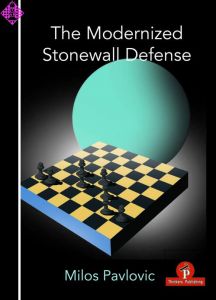Article Number
LOPAVTMSO
Author
The Modernized Scotch Game
A Complete Repertoire for White and Black
280 pages, paperback, Thinkers Publishing, 1. edition 2019
The Scotch was one of the first modern openings to appear in tournament practice. The nature of the Scotch fitted perfectly into the 19th century era of Romantic chess the opening’s emphasis on opening lines, fast development, rapid centralisation and, most importantly, fast attacking chances, meshed seamlessly with the style of the day. In a stylistic sense the Scotch very much resembles Open Sicilian positions.
In spite of its long history however, for most of its life the Scotch did not enjoy great popularity. It was a recognized answer to 1… e5, for sure, but it never seriously challenged the Ruy Lopez as the most ”objective“ way to fight for an opening advantage. The general opinion was that Black had enough resources to achieve equality. The turning point for the fortunes of the Scotch was the world title matchbetween Kasparov and Karpov in 1990, the first time that the opening had been tested at such an elite level. Unsurprisingly, Kasparov’s decision to employ this old opening meant that its appearances in tournaments soared. The popularity of the Scotch generated by this match remains today, and I would say it is perhaps more popular than ever before. That begs the obvious question why? Well, due to the nature of the positions that tend to arise it is ideal for engine analysis, and so it lends itself perfectly to the tools of the current day. It is a nice paradox that the Romantic foundations of this opening merge so well with the computerized modern era. Credit can mostly be given to Kasparov for reviving this old opening, but there are many others who have contributed to exploring new ideas and forging new paths. A lot of discoveries have been made by some young grandmasters who don’t shy away from analysing deep tactical solutions with the aid of the silicon beast.
The only other book written on the Scotch that I used whilst searching for material is the excellent work by the English GM Peter Wells, The Scotch Game. Wells’ book comes from an older, classical style of opening literature which is helpful in developing the reader’s understanding and certainly still has its merits today. Since its publication in 1998, however, many new lines have been introduced and our general approach to the Scotch has changed dramatically. Nevertheless, it served me well as guidance as I wrote this work. This book is going to be a big one, so my introduction will be a little different to my usual approach. I will try to present the most important features in the book so that readers can immediately see what kind of material they will find.
In spite of its long history however, for most of its life the Scotch did not enjoy great popularity. It was a recognized answer to 1… e5, for sure, but it never seriously challenged the Ruy Lopez as the most ”objective“ way to fight for an opening advantage. The general opinion was that Black had enough resources to achieve equality. The turning point for the fortunes of the Scotch was the world title matchbetween Kasparov and Karpov in 1990, the first time that the opening had been tested at such an elite level. Unsurprisingly, Kasparov’s decision to employ this old opening meant that its appearances in tournaments soared. The popularity of the Scotch generated by this match remains today, and I would say it is perhaps more popular than ever before. That begs the obvious question why? Well, due to the nature of the positions that tend to arise it is ideal for engine analysis, and so it lends itself perfectly to the tools of the current day. It is a nice paradox that the Romantic foundations of this opening merge so well with the computerized modern era. Credit can mostly be given to Kasparov for reviving this old opening, but there are many others who have contributed to exploring new ideas and forging new paths. A lot of discoveries have been made by some young grandmasters who don’t shy away from analysing deep tactical solutions with the aid of the silicon beast.
The only other book written on the Scotch that I used whilst searching for material is the excellent work by the English GM Peter Wells, The Scotch Game. Wells’ book comes from an older, classical style of opening literature which is helpful in developing the reader’s understanding and certainly still has its merits today. Since its publication in 1998, however, many new lines have been introduced and our general approach to the Scotch has changed dramatically. Nevertheless, it served me well as guidance as I wrote this work. This book is going to be a big one, so my introduction will be a little different to my usual approach. I will try to present the most important features in the book so that readers can immediately see what kind of material they will find.
| EAN | 9789492510648 |
|---|---|
| Weight | 520 g |
| Manufacturer | Thinkers Publishing |
| Width | 17 cm |
| Height | 24 cm |
| Medium | Book |
| Year of Publication | 2019 |
| Author | Milos Pavlovic |
| Language | English |
| Edition | 1 |
| ISBN-13 | 9789492510648 |
| Pages | 280 |
| Binding | paperback |
| Name | Thinkers Publishing BV |
|---|---|
| Adresse | Moorstraat 12 Landegem 9850 Belgien |
| Internet | www.thinkerspublishing.com |
| KnightToF3@hotmail.com |
005 Key to Symbols
007 Preface
008 Introduction
PART I - 4…Nf6
017 Chapter 1 - Scotch Four Knights
035 Chapter 2 - Minor lines in the Mieses Variation
045 Chapter 3 - Sidelines on move 8
063 Chapter 4 - White plays 8.Nd2
081 Chapter 5 - Alternatives on move 9 and 10
093 Chapter 6 - White plays 10.f4
109 Chapter 7 -White plays 10.g3
PART II - 4…Bc5
125 Chapter 8 - Answering 5…Qf6 with 6.Qd2
139 Chapter 9 - Answering 5…Qf6 with 6.Qf3
159 Chapter 10 - Minor lines
175 Chapter 11 - Black replies to 7.Bc4 with 7…Ne5
189 Chapter 12 - Black replies to 7.Bc4 with 7…0-0
205 Chapter 13 - Alternatives on move 5 and 6
221 Chapter 14 - The main lines: 6…d6 and 6…Nf6
PART III - Other 4th moves
253 Chapter 15 - Black alternatives on move 4
277 Appendix - White plays 4.c3 (Göring Gambit)
007 Preface
008 Introduction
PART I - 4…Nf6
017 Chapter 1 - Scotch Four Knights
035 Chapter 2 - Minor lines in the Mieses Variation
045 Chapter 3 - Sidelines on move 8
063 Chapter 4 - White plays 8.Nd2
081 Chapter 5 - Alternatives on move 9 and 10
093 Chapter 6 - White plays 10.f4
109 Chapter 7 -White plays 10.g3
PART II - 4…Bc5
125 Chapter 8 - Answering 5…Qf6 with 6.Qd2
139 Chapter 9 - Answering 5…Qf6 with 6.Qf3
159 Chapter 10 - Minor lines
175 Chapter 11 - Black replies to 7.Bc4 with 7…Ne5
189 Chapter 12 - Black replies to 7.Bc4 with 7…0-0
205 Chapter 13 - Alternatives on move 5 and 6
221 Chapter 14 - The main lines: 6…d6 and 6…Nf6
PART III - Other 4th moves
253 Chapter 15 - Black alternatives on move 4
277 Appendix - White plays 4.c3 (Göring Gambit)
More from Thinkers Publishing








